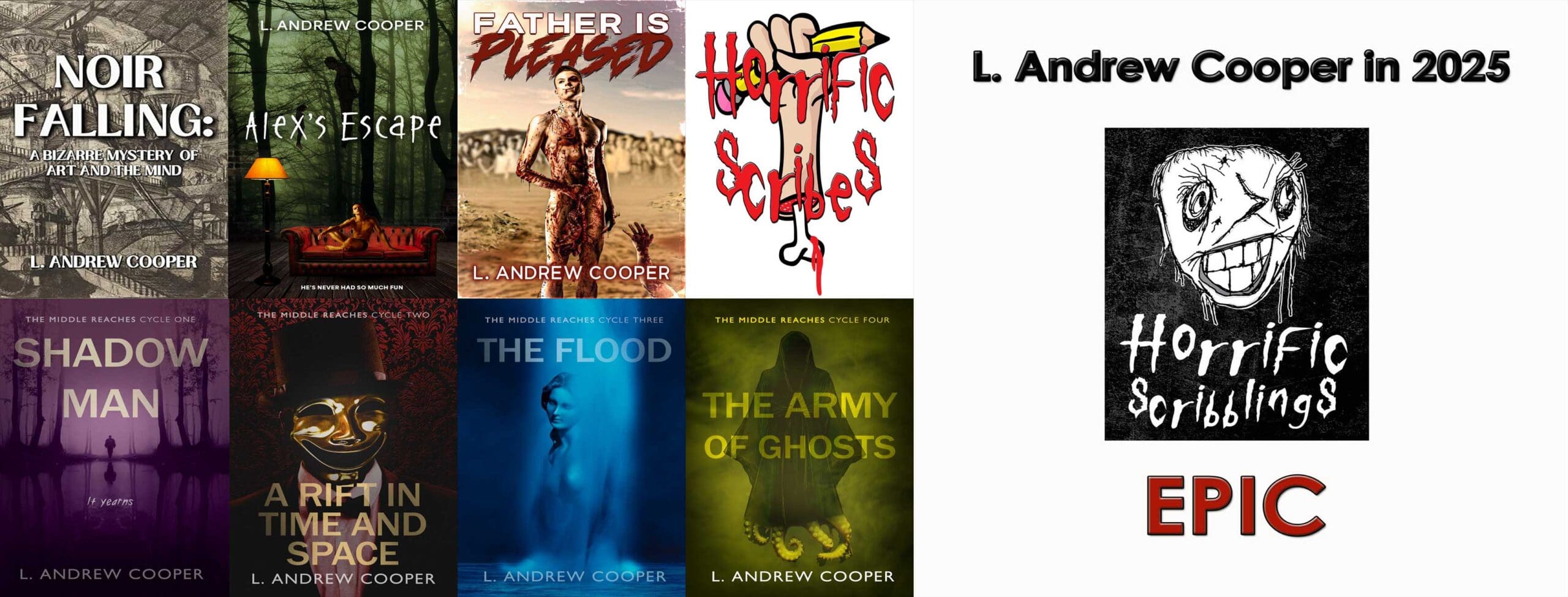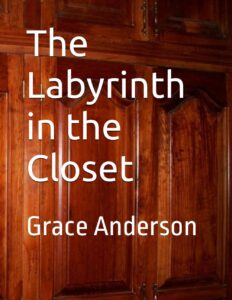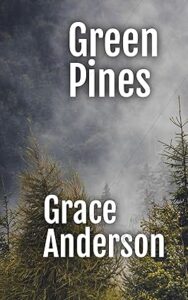Emerging author Grace Anderson talks about generational trauma, the boundaries of gender, and the power of paranoia in this interview about her books The Labyrinth in the Closet and Green Pines.
The Labyrinth in the Closet
After a spell of boredom on a hot summer day in 1958, twelve-year-old Lois and her friends stumble across a mysterious passageway hidden in the back of her mother’s closet. They discover a mysterious map that points to treasure for those brave enough to seek it out. The four girls embark on a journey through this strange labyrinth in search of the promised riches. However, the labyrinth is not as innocent as it appears, and the obstacles it throws at the girls threaten both their friendships and their lives.
The Goonies meets Alice in Wonderland, this dark fairy tale adventure is sure to keep you on the edge of your seat.
Green Pines
A young man named Gavin is struggling to provide for his young sister after the death of their parents. When he is offered a job at an isolated campground, he accepts it in hopes of providing a better life for his sister. However, the campground soon proves to be more than what it seems, as a series of strange occurrences causes Gavin to question his sanity and the safety of himself and his sister. With the help of his coworkers and best friend, a conspiracy theorist, Gavin sets out to uncover the truth behind the mysterious campground. However, will he survive the sinister forces that lurk within?
The Interview
1. Labyrinthine Youth. Though both Labyrinth in the Closet and Green Pines qualify as “dark fiction,” one of Labyrinth in the Closet’s main categories on Amazon—I think rightly—is “Coming of Age Fantasy.” The main characters are kids, the violence of their adventure is relatively mild, and though the older kids drop some f-bombs, the story offers little to offend. What age ranges do you think will respond best to the book? As characters work their way through the labyrinth, they also work through conflicts that require mature reasoning. To what extent is the labyrinth a metaphor for coming of age itself? What attracted you to the idea of kids struggling through a labyrinth for your story and setting?
GA: The idea for The Labyrinth in the Closet came about when I decided I wanted to write a female counterpart to The Goonies. The Goonies is widely considered to be enjoyable and relatable to all ages despite the main characters being children. I’d like to think The Labyrinth in the Closet has the same effect.
The labyrinth in the book is supposed to be more of a metaphor for a tragic loss of innocence rather than a traditional coming of age. The Labyrinth is a metaphor for the loss of the simple, idealized version of the world that occurs as a child grows up. The girls are discovering that the world is more dark, dangerous, and complicated than they once believed it to be. The labyrinth is a physical representation of that.
I found the idea of the labyrinth attractive due to the universal mystery of it. The Labyrinth in the Closet was very loosely inspired by Coraline, one of my childhood favorite books and movies. I took the idea of a wide expansive portal world hidden away in a seemingly normal unassuming house from that story. I always liked the idea of something strange and otherworldly being hidden away in something that would usually be considered mundane.
2. Dark Inheritance. A lot of the darkness in Labyrinth in the Closet appears in the characters’ backstories, particularly in their parents’ histories and the ways those histories have affected them—trauma, depression, alcoholism, and a detailed episode involving sexual exploitation of a minor. Why do you focus on these dark histories and their impacts on the younger generation? Do you think your characters are unusual as heirs to so much trouble, or do you think most kids inherit similar baggage? What are you saying about kids charting their own identities while still in the shadows of prior generations?
GA: All of my work centers around generational trauma. I believe what kind of family situation a character grew up in is an important factor in understanding them and why they think and act the way they do.
I think all children are impacted by their parents’ traumas. The mental state and experiences of a parent have a massive impact on how they raise their children and thus the kind of people their children become. That is something that I feel is worth exploring and dissecting through fiction.
Another theme I aimed to explore in The Labyrinth in the Closet is how children carve out their own identities and life paths in the wake of generational trauma. When the girls are in the labyrinth, they are free from the control and guidance of their parents. They are experiencing their first taste of independence, but even so, they can never be completely free from their parents’ traumas. The experiences of their parents are always going to shape the people they become.
3. Histories in History. Although I’m not sure the book provides a specific date, the description of Labyrinth in the Closet says it’s set in 1958, which fits with the book’s details. Why did you choose this time period? How does it affect the story and characters? How might the story and characters differ if the setting were in the present?
GA: All of my works are set in some kind of past time period. I believe the overuse of things like modern technologies and slang really ages a work of fiction and makes it less timeless.
I chose 1958 in particular due to the restrictive gender roles of that time period. The girls in the story are a lot rougher and crasser than what was expected of girls and women in the 1950s. I felt like that was an interesting subversion.
I think the addition of modern items like cell phones and the internet would be detrimental to the story as a whole. Setting the story in modern times would take away from the mystique and atmosphere.
4. Girls Trying to Escape. The kids who go on the adventure in Labyrinth in the Closet are all girls. To what extent is the book specifically an examination of female friendship, and what dynamics do you bring to the fore? So much of the story focuses on trying to escape feelings of entrapment and fearing punishment from strict parents—are you saying something in particular about difficulties girls face growing up? How might adding a boy to the group have changed your vision?
GA: The dynamic between the girls was written the way it was to subvert the expectation that young girls are always sweet and soft, especially during that time period. The girls fight, they cuss at each other, and they’re pretty cruel to one another at times. I feel like this is a more realistic and raw depiction of how young girls interact with each other.
There are definitely themes of how girls are treated harshly by their parents and by extension by society. There are certain behavioral expectations placed on young girls that may not be entirely achievable all the time. Young girls of that time were not really allowed to openly express their emotions and opinions without negative consequences from both their parents and society as a whole. I think a lot of aspects of that ring true even today.
It was important to me to have an all-female cast of characters so I could explore female friendship dynamics and gender expectations. Honestly, if I added a boy to the cast, I think the girls would eat him alive.
5. Changing Categories. The Labyrinth in the Closet has many dark elements and flirts with the supernatural, but Green Pines falls more squarely into “horror” categories. What makes Green Pines horror, and what inspired you to travel more deeply into darkness for this book? Do you think audiences for the two books are the same? Why or why not?
GA: I wrote The Labyrinth in the Closet with a more realistic (relatively speaking), magical realism story in mind. I’m a horror author first and foremost. I’ve been writing horror since I was nine years old, but for my first published full-length novella, I wanted to venture more into fantasy territory and save the more disturbing material for when I found my footing as an author.
I think the same people who enjoyed Green Pines will enjoy The Labyrinth in the Closet, but if a reader is particularly sensitive to disturbing themes, they may prefer The Labyrinth in the Closet.
6. More Parent Problems. In The Labyrinth in the Closet, parents are usually problematic or absent, and in Green Pines, the main characters’ parents are dead, leaving the older brother to care for his younger sister. What drew you to make parent problems a catalyst for conflict, internal and external, again in Green Pines? How traumatized are Gavin and his sister by the loss of their parents, and how does that trauma shape the story?
GA: I’ve known many people who have lived with abusive alcoholic parents in my personal life. I know how deep of a wound that can leave on a person’s psyche. We experience all the challenges and tragedies of being human through stories. Because of this, I’ve always thought that generational trauma is a very important thing to explore through fiction, particularly when it comes to things like abuse and addiction.
The trauma that Gavin and Rosie experience both brings them closer together and causes a lot of stress between them. It also forces them to persevere through all the challenges they face together. In the beginning, Gavin is not very confident in his ability to properly care for Rosie, but he still takes responsibility for her because he has no other choice. Despite the book’s ending, Gavin grows as a character and becomes stronger through this sense of responsibility.
7. Questioning Sanity. The strange occurrences at the campground in Green Pines make Gavin question his sanity. Your bio emphasizes that your “work centers around grief, mental health, and all the emotional ups and downs that come with being human.” How do you represent Gavin’s struggles with his sanity, and how central are those struggles to the book? Should readers expect to question his sanity along with him?
GA: The nature of the Green Pines campground is to make its workers question their sanity. This is how it maintains its control over its victims. This manipulation is central to the main conflict and encourages the readers to question what is real and not real right along with the characters.
8. Conspiracy! The description of Green Pines lists a “conspiracy theorist” among Gavin’s helpers. How much of the story revolves around possible conspiracies and conspiratorial thinking? Together with strange occurrences that lead one to question one’s sanity, the presence of conspiratorial thinking suggests that you’re exploring one of horror fiction’s most venerable subjects—paranoia. Would you describe Green Pines as a paranoid tale? Why or why not? Are the characters paranoid? Will readers feel paranoid as they follow Gavin in trying to solve the mysteries?
GA: Timothy is the conspiracy theorist of the group. All the other characters roll their eyes at his ideas that they deem unreasonable or even crazy until he is ultimately proven right. This creates a lot of growth in the characters and tension in the plot.
Paranoia is an important aspect of all effective horror stories, so I tried to utilize it as much as possible in Green Pines.
The events in Green Pines are meant to provoke paranoia in both the characters and the reader. They’re supposed to make you question what is real and what’s not real. That is where most of the scares and tension stem from.
9. Access. How can readers learn more about you and your works (please provide any links you want to share)?
GA: https://graceandersonauthor.com/
https://www.instagram.com/graceandersonauthor/
https://www.tiktok.com/@graceandersonauthor?lang=en
About the Author
Grace Anderson is an up-and-coming indie author based out of Denver, Colorado. Her work centers around grief, mental health, and all the emotional ups and downs that come with being human. When she’s not writing, she enjoys reading, thrift shopping and sipping chai at local coffee shops.




